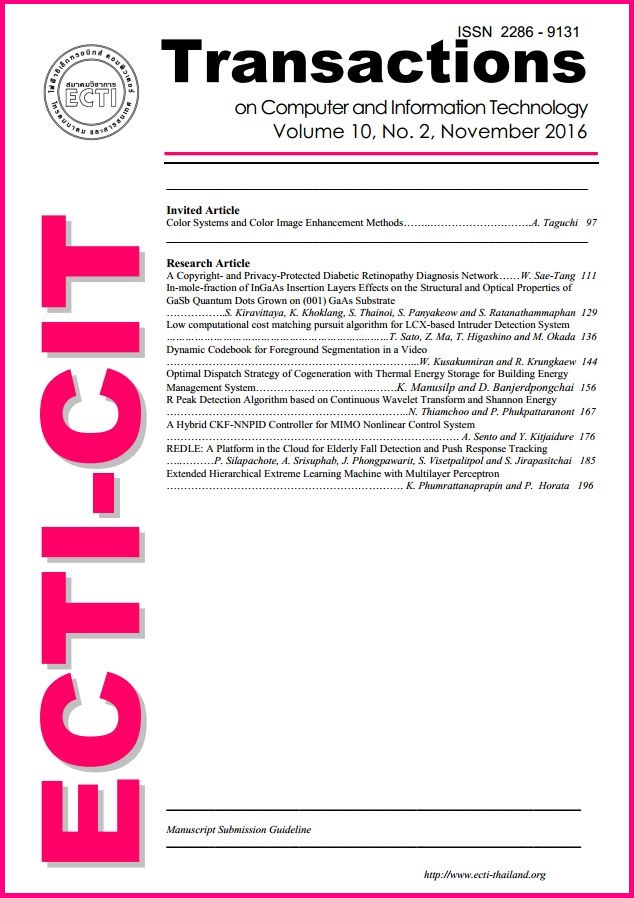Low computational cost matching pursuit algorithm for LCX-based Intruder Detection System
Main Article Content
Abstract
The leaky coaxial cable (LCX) based intruder detection system detects intruders by making efficient use of time-variation of the channel impulse response among the cables. Recently, a compressed sensing (CS)-assisted intruder detection system has been proposed for improving the accuracy of the intruder detection. Although the CS-assisted system can improve the false detection probability performance efficiently, it is difficult to implement it because of its huge computational cost requirement. This paper proposes a modified matching pursuit (MMP) algorithm for reducing the computational cost of the CS-assisted intruder detection scheme. MMP can reduce the computational cost by limiting the search range in the vicinity of impulse response peaks estimated at the last measurement. Computer simulation results show the proposed system can reduce the computational cost for the conventional CS-based
algorithm without degradation in the false detection performance.
Article Details
References
K. Inomata and T. Hirai, “Microwave backprojection radar for wide-area surveillance system,” 34th European Microwave Conference, vol. 3, no. 11, pp. 1425–1428, Oct 2004.
K. Nishikawa, T. Higashino, K. Tukamoto, and S. Komaki, “TDOA based wireless positioning method using leaky coaxial cable [in japanese],” Low computational cost matching pursuit algorithm for LCX-based Intruder Detection System 143 The transactions of the Institute of Electronics, Information and Communication Engineers. B, vol. J92-B, no. 1, pp. 320–327, Jan 2009.
K. Inomata and T. Hirai, “An analysis of propagation loss characteristics in indoor short range wireless communications using ray-tracing technique [in japanese],” Technical report of IEICE, vol. SANE2005, no. 101, pp. 29–34, Feb 2006.
T. S. Okada, “A study on detection accuracy for intruder detection system using leaky coaxial cable,” 2012 International Conference on Embedded Systems and Intelligent Technology, pp. 167–170, Jan 2012.
G. Marubayashi, M. Nakagawa, and R. Kohno, Spread Spectrum Communication and Its Applications. The Institute of Electronics, Information and Communication Engineers, 1998.
S. Stein and J.Jay.Jones, Modern Communication Principles With Application to Degital Signaling. McGRAW HILL, 1970.
A. Goldsmith, Wireless Communications. New York: Cambridge University Press, 2005.
D. L. Donoho, “Compressed sensing,” Information Theory, IEEE transaction on, vol. 52, no. 4, pp. 1289–1306, Apr 2006.
T. Tanaka, “Mathematics of compressed sensing,” IEICE Fundamentals Review, vol. 4, no. 1, pp. 39–47, June 2010.
W. U.Bajwa, J. Haupt, G. Raz, and R. Nowak, “Compressed channel sensing,” Conf. Information Sciences and Systems, pp. 5–10, Mar 2008.
W. U.Bajwa, J. Haupt, A. M.Sayeed, and R. Nowak, “Compressed channel sensing: A new approach to estimating sparse multipath channels,” Proceedings of the IEEE, vol. 98, no. 6, pp. 1058–1076, June 2010.
J. A. C.Gilvert, “Signal recovery from random measurement via orthogonal matching pursuit,” IEEE Transactions on Information Theory, vol. 53, no. 12, pp. 4655–4666, Dec 2007.


